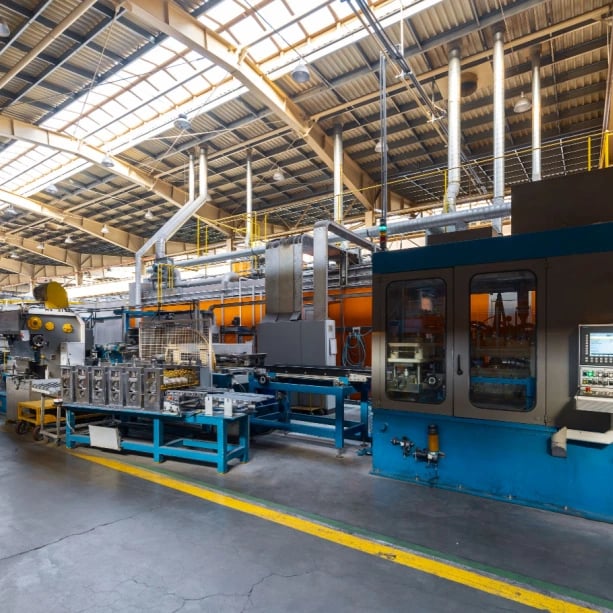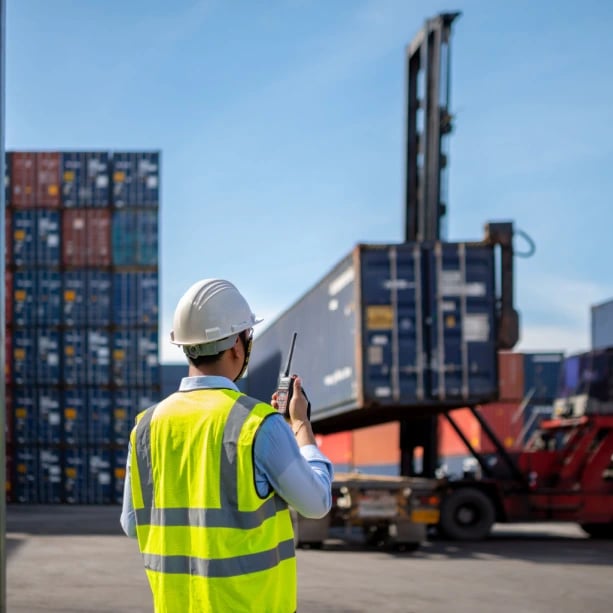Looking to learn more from one of our team members?
Asset Tracking & Asset Monitoring
Track your most important assets both indoors and outdoors in real time to optimize your manufacturing and logistics operations.

The demand for asset tracking and asset management solutions is accelerating rapidly. It’s recently become important to companies to have visibility of their most important assets. Learn everything you need to know to stay ahead of the curve, along with the ideal solutions to implement.
Although the terms asset management and asset tracking are often used interchangeably, they are actually two distinct concepts.
Asset Management
Organizations of all types – from manufacturing, logistics, and construction operations included – own and/or lease a variety of essential assets that are critical to everyday business operations. For example, logistics companies must have a fleet of vehicles to deliver products, and manufacturers need the proper tools and equipment to manufacture products to sell.
It’s important that these assets remain fully functional throughout their lifecycle, which is where a good asset management strategy comes into play, as it establishes a systematic process for overseeing your physical resources. As such, it provides both a framework and a method for maintaining such critical lifecycle information as asset value, use, condition, maintenance, depreciation, and operating cost.
Asset Tracking
If asset management is a strategy for maintaining your assets, then what is asset tracking? To put it simply, asset tracking is a component of your asset management strategy – certainly, the most important component – which enables you to have visibility of the location and condition of your assets. Thanks to digital technology, there are a variety of automated systems for tracking your high-value resources in real time, both indoors and outdoors, under any number of environmental conditions.
Of course, asset management affords innumerable benefits for businesses of all types and sizes, beginning with increased customer satisfaction. When your operations run smoothly, your customers not only have fewer complaints, but a much better experience overall, which inspires greater loyalty to your company and your brand.
With an effective asset management strategy and a good asset tracking system, you will also improve productivity, efficiency, and safety to even further bolster your company’s capacity. Having valuable asset use, condition, and maintenance data at your fingertips makes it much easier to budget and plan for the future. And when you know where your assets and personnel are at all times, you can guard against theft, loss, and unsafe conditions.
It is equally important to implement a solid strategy that incorporates “right fit” asset tracking software that can pave the way for ensuring regulatory compliance vis-à-vis both internal and external industry requirements. For example, a distributor of perishable items, like food or pharmaceuticals, is able to uphold FDA compliance regulations through the monitoring of nonperishables and notification of in-transit temperature changes.
Businesses have always been driven to keep up with the many valuable resources they need to operate successfully. And before the dawn of more sophisticated methods like barcode asset tracking, that meant using pen-and-paper strategies to manually count and record the assets on hand. It was a tedious, labor-intensive process that was not only prone to human error, but incredibly difficult to scale as businesses grew and assets multiplied.
It was a great relief when, in the 1970s, barcodes began making their way into the mainstream of manufacturing, warehousing, retail, and logistics operations. These scannable asset identification codes could be affixed to anything. Relying on these scans helped mitigate some of the human error caused by counting and transcription mistakes.
Then came the Internet, which heralded the introduction of digital asset tracking spreadsheets. This innovation took barcodes to the next level by storing and displaying the data they produce in a central, online format that can be updated in real time and easily shared. It was an inexpensive yet relatively reliable way to track assets, as long as the data was accurately entered. On top of that, these spreadsheets have greatly improved with time, now enabling complicated calculations and data visualization formats like charts and graphs.
Continuous advancements in digital technology gave rise to the Internet of Things – or IoT – which empowers us to connect billions of devices, objects, animals, and people in ways previously unimagined. This new era ushered in a sophisticated array of cost- and resource-efficient indoor and outdoor location tracking technologies that no longer rely on manual data input. By completely taking out the human element of asset tracking, these systems were able to successfully eliminate common human errors.
Real-time location systems (RTLS), such as Link Labs’ AirFinder solution, utilize advanced technologies like Bluetooth Low Energy to help you keep tabs on your assets at all times, providing a solution that works for parts, equipment, personnel, supplies, and even more.
IoT-based asset tracking solutions such as this one have also done away with the need for costly IT infrastructure, which reduces the ongoing expenses associated with some of the earlier, more power-hungry asset tracking systems. They are also easily scalable, which means you can start small and work your way up and across the organization. And when you put it all together, these “intelligent” real-time asset tracking systems provide a significant return on investment by saving you both time and money, providing a big boon to productivity and profitability.
As asset tracking systems become increasingly smarter, the market continues to grow, giving rise to a multitude of innovative solutions that vary in function, complexity, and cost. So, before you begin the selection process, you will want to nail down a few basics: (1) what you are tracking, (2) where you are tracking it, (3) how you are tracking it, and (4) who pays the bill.
With that information in hand, you are now ready to explore the range of currently available IoT asset tracking technologies. Here’s a brief overview.
Indoor Positioning
QR Codes
QR codes have taken their predecessor, the barcode, to greater heights. In fact, they are quickly becoming the cornerstone of inventory control, as highly affordable and easily affixable tags that can be scanned with something as ubiquitous as a smartphone. Unlike barcodes, QR codes are two-dimensional, which means they can be “read” from any angle and are capable of transmitting far more information.
RFID (Radio Frequency Identifier)
RFID tags can also be a cost-effective choice for tracking inventory as it enters and leaves a warehouse or retail facility. Put simply, RFID is a form of wireless communication that uses radio frequency signals to send and receive messages from asset tracking tags. These tags fall into one of two types: passive and active.
The battery-free passive variety transmits signals to an antenna that bounces them back to a reader located at a specified “choke point.”
Battery-powered active tags work in tandem with Bluetooth beacons to continuously transmit an abundance of data, including environmental conditions like temperature and humidity.
WiFi
WiFi-enabled indoor positioning systems work off of local networks, using radio waves to rapidly broadcast a great deal of information. Because the network infrastructure is wide-ranging and standardized, these systems are easy and inexpensive to install.
Bluetooth LE
BLE is a form of wireless communication that conserves energy by entering sleep mode while not in use. BLE allows asset tracking devices to communicate with one another to deliver messages, operating with a lower transfer rate than Bluetooth since it doesn’t require a continuous stream of data.
Xtreme Low Energy
Our groundbreaking XLE® technology uses phase-ranging protocols to determine location with up to 1 meter of accuracy. Phase-ranging is a type of two-way time of flight (ToF) measurement that uses the smallest amount of energy possible to communicate between devices.
Read more about Xtreme Low Energy
Ultra-Wideband
Ultra-wideband technology provides up to 30 centimeters of accuracy, using high frequencies to communicate with devices to determine location. Typically, UWB has a high power-consumption rate, but when combined with XLE®, the batteries on our devices can last up to 7 years.
Outdoor Positioning
GNSS/GPS
Satellite-based positioning technologies such as GNSS and GPS are the most commonly used location technologies for outdoor asset tracking. In essence, they employ receivers to collect radio signals that are transmitted through a collection of satellites that circle the Earth. They then use these signals to accurately calculate and identify an outdoor location that is expressed as latitude and longitude.
These systems are highly accurate as long as the tracking device has a clear view of the sky. But they struggle to “hear” the signals they need to function once you leave the open road and move into urban environments with tall buildings, densely wooded areas, and/or enclosed spaces like buildings, tunnels, or containers. And given that GNSS/GPS is a power-thirsty process, these devices have measurably shorter battery life than other outdoor tracking technologies.
WiFi Sniffing
As a viable alternative to GPS, WiFi sniffing technology uses available networks to generate location information without connecting to the networks directly. The more data it collects, the more accurate the result, making it ideal for urban environments. It is also more power-efficient than GPS and performs more effectively in enclosed spaces like buildings and tunnels.
Cellular ID
As its name implies, Cellular ID uses cell tower transmissions to triangulate outdoor position. It is not only the simplest outdoor tracking technology you can use, but the most efficient; it requires far less power than either GPS or WiFi sniffing, although there is a decrease in accuracy. Yet while it may not be a “right fit” as a primary solution, it makes a good backup location finder for areas that don’t work as well with GPS and WiFi sniffing.
Now that you have a basic handle on the current universe of asset tracking technologies, it’s time to set your sights on a software solution that complements your asset management strategy. And in doing so, you will probably want to choose one that includes these two components: asset identification and asset location. In other words, you need to know that you are managing the right assets (asset identification) and where those assets are at any given time (asset location).
Although optical marking technologies like barcodes and QR codes are a simple, cheap, and ubiquitous method for identifying low-value retail items at the point of purchase, they do not transmit location data. This means you know what the asset is but not where it is.
On the other hand, there are a growing number of automated asset tracking solutions that utilize technologies like GPS and active RFID to connect asset identity with asset location. GPS generates identifying information like serial numbers, along with outdoor location coordinates, while active RFID tags provide indoor positioning in real time.
And if you need something that covers both indoor and outdoor scenarios, Link Labs has its innovative asset tracking software product, AirFinder. The first of its kind, this highly flexible asset visibility system combines asset identification and location technologies to automatically provide seamless visibility as assets move between both indoor and outdoor locations.
As you begin to explore your available options for a “right fit” asset tracking solution based on your unique requirements, there are three key business considerations to keep in mind:
Know your goals. The idea here is to come up with a set of realistic goals that not only align with your identified asset management needs but also help frame the business processes you plan to develop for monitoring the assets you have.
Plan for future success. Given that your needs will most likely change over time, you will want to make sure that you have an asset management strategy and solution that can evolve with them. For example, by knowing who your stakeholders are now and who they might be down the road, you will be better equipped to align your requirements accordingly. The same goes for mapping your asset lifecycle from purchase through replacement, so you may properly budget and plan for each stage.
Define a method for measuring ROI. The asset tracking solution you choose should not only get the job done effectively and efficiently, it should also yield a healthy return on investment. That will mean having a system and a set of metrics in place for evaluating both, with an eye toward actionable insights.
As technologies become smarter, businesses are ramping up for digital transformation, particularly with respect to IoT asset management. So, to help you plan your trajectory, we have identified four stages to use in benchmarking your transformation journey.
Stage 1 - Pen, Paper, and Whiteboards: As we discussed earlier, asset tracking began – and in some settings continues to operate – with rudimentary lists and sign-out sheets, manually created with the help of pen and paper or whiteboards.
Stage 2 - Asset Tracking Spreadsheets: When Excel spreadsheets emerged in the 1980s, businesses rushed to digitize their asset tracking process. While this approach made the job easier, it still relied on manual input and updates and was thus still subjected to human error.
Stage 3 - Cloud-Based Asset Management Software: With the dawn of IoT-based asset tracking software, automated tracking became a reality. Indeed, by deploying real-time location systems, businesses are now able to generate reams of valuable asset management information that empowers them to improve their business processes.
Stage 4 - Machine Learning and AI: The next generation of asset tracking technology – which is still evolving – will fulfill the promise of digital transformation by fundamentally changing the way enterprises conduct business and deliver value. This technology will pave the way for companies to fully automate the asset management decision-making process while eliminating most of the constraints caused by reliance on human input.
AirFinder is the only solution to provide seamless indoor and outdoor location tracking. Our system combines different location technologies to provide best-in-class location accuracy while preserving power efficiency and affordability.
Our solution isn’t one size fits all: instead, it can be tailored to your needs. Whether you need to track your tools or monitor your cold chain, we have the solution you need; if you have many different needs, they can be addressed using the same system.
We employ the most affordable high-accuracy tags on the market. Additionally, we provide long-lasting battery life to further reduce overall costs.
Our solution is scalable worldwide and can integrate seamlessly with existing MQTT or API platforms. This gives you the ability to access all your crucial operational data in one place.
You’ll see immediate and measurable ROI when you use the lowest-cost indoor RTLS on the market that can be deployed in a matter of not weeks, not days, but mere hours. Further, AirFinder can support other Bluetooth applications on the same network, providing options for a robust indoor asset tracking system that’s built to fit your needs.
Learn more about AirFinder OnSite
Whether you want to leverage GPS, WiFi sniffing, or cellular ID for outdoor asset tracking, Link Labs can help. By using a combination of these technologies, our asset tracking solution makes monitoring the status of assets moving between facilities easier than ever. Further, you can easily integrate environmental monitoring sensors into your real-time location tags to gain more information about sensitive cargo during transit.
Learn more about AirFinder Everywhere
If you need to track your assets both indoors and outdoors, you can do it all with one solution. You don’t need to purchase two separate systems, our tags seamlessly move indoors and outdoors while providing asset location and condition data without disruption.Worlds Finally Collide: Indoor/Outdoor Asset Tracking | White PaperThis white paper explains how we use seamless indoor and outdoor asset tracking to help companies improve their manufacturing and logistics operations.

Cellular-based asset tracking systems are expensive and unnecessary for assets that stay in a defined area, and using RFID or Bluetooth Low Energy (BLE) can require a lot of expensive infrastructure to install. But blending a powerful long-range system like Symphony Link with GPS or BLE minimizes costs and opens up a world of possibilities.
Pulling wires to RFID readers and connecting them to existing WiFi networks is both expensive and time-consuming, but a Symphony integration is simple, with no IT integration necessary.
Aside from Symphony Link, no other existing technology can monitor assets on the frontier of IoT without a significant investment in infrastructure.

Manufacturing companies face many pressures to have tasks complete on a daily basis. The goal of implementing a tracking solution is to obtain efficiency throughout the entire production line.
Learn more about asset tracking for manufacturing operations


An asset tracking solution allows your company to track remote assets to provide real-time data on shipments and equipment. Your company will now have full visibility to ensure that goals are met.
Learn more about asset tracking for logistics operations


It’s important to find a solution tailored to meet your specific needs. Discover how Link Labs AirFinder solution can be a perfect match for your company with our many use cases for asset tracking.
Learn more about asset tracking for other industries


Election security is one of the most pressing topics of our time. For election administrators, the mission is simple but
Read More